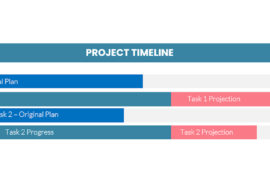 I suppose it shouldn’t surprise me. After all, it’s been 25 years and the request is almost identical each time. Again this week a very senior project manager asked for it again. “It” is a real-time, integrated project management system. The request came in a round-about way while I was demonstrating software for enterprise-wide use in a project environment so I had to double check. “Let me just be sure that I understand what you’re asking for,” I asked. “You’d like an enterprise-wide, web-based project management system that would manage its data in real time. In such a system the CEO for example, could click on a button and see a view of where all project stand at this moment. If they were to return in a few hours, the view would now represent all the changes that had occurred in the intervening time.”
I suppose it shouldn’t surprise me. After all, it’s been 25 years and the request is almost identical each time. Again this week a very senior project manager asked for it again. “It” is a real-time, integrated project management system. The request came in a round-about way while I was demonstrating software for enterprise-wide use in a project environment so I had to double check. “Let me just be sure that I understand what you’re asking for,” I asked. “You’d like an enterprise-wide, web-based project management system that would manage its data in real time. In such a system the CEO for example, could click on a button and see a view of where all project stand at this moment. If they were to return in a few hours, the view would now represent all the changes that had occurred in the intervening time.”The project manager’s eyes lit up. “You understand completely,” he said.
It fell to me to give him the bad news. “Such a system is demonstrable,” I said, “but could never be implemented.”
He was crushed. Who can blame him frankly? I remember standing in the exhibit hall of the annual Project Management Institute Symposium with the senior executives of two of the largest and long-standing project management software vendors. We were shaking our heads as we looked over the exhibit floor. Every booth it seemed was offering the same thing: “Enterprise-wide web-based project management”.
With all the promises from all these vendors of project management tools that offer this type of solution, surely at least one of them has figured out how to actually deliver it.
The problem is, that it’s not a technical problem. You see, as desirable as such a real-time report seems at first blush, it’s virtually impossible to deliver. The first issue is the context of the data you’re looking at. If I present a report of the status of a project, there are some basic assumptions that people make about the report. You assume, for example, that the data is accurate to the best of my abilities. To be accurate, project management data needs to go through at least some kind of review. You also assume that you’re looking at apples and apples, not a mix of different kinds of data. For example, if I show a report with 10 projects summarized on it, you would reasonably assume that the projects had all been statused on or around the same time. A report showing the status of some reports as of this week and others as of last month would be at best nonsensical and at worst could show a misleading view of our distribution and loads of resources.
This means that to create any such report prior to displaying it to management, I really need to update data on or around the same time and then validate that data through someone responsible for the project. This is the definition of batch processing. It is the very antithesis of real-time.
As soon as I point these kinds of issues out, it becomes obvious that there is going to be no easy solution to this request regardless of what the different booth displays say on the exhibit floor but there is another element of the issue that is almost never asked of the requestor.
Such requests typically originate from someone in the executive suite. A manager or director or senior executive of some kind asks why, with all the products on the market that promise such features, can’t he or she get the real-time analysis they’re asking for.
My first question of such people is “What will you do with it?” It seems trite I suppose but it’s really not. Imagine for a moment, such a system in place. Let’s imagine that through a petition to Harry Potter and his magic wand, we’ve managed to resolve all the issues with collecting, analyzing and validating our project data. Now, it’s 9:00am in the morning and our CEO is checking on the projects. He (or she) pops up the “corporate-wide-real-time-budget-vs-actual project report” Bad news. It shows the actual cost curve slightly higher than the budget curve. Our combined projects are over-budget. But wait! It’s 9:05 and the curve has just changed. Our budget curve has moved up, now the variance is alright. The CEO breaths a sigh of relief. Wait again! The curve has changed. It’s 9:15 and Bob, down in projects has just updated a half-dozen tasks with their new projected finish dates, now the curve is showing us over-budget again and we’re running late besides! But wait! The curve is undulating again. Even if this hapless manager were to take a snapshot and run down to the project department with it to ask how we’re going to get on track, the response is likely to be “Oh, you’re looking at the 10:23am report, you really need to look at 10:45, the picture’s all different.”
It’s obvious that such an environment would be completely unproductive yet the desire for it continues year after year unabated. This brings us back to the now dejected project manager who I met this week who wanted to know what he should do now? My recommendation was to change his question. Instead of searching for the real-time project management system, why not start asking what changes to his project management environment could he implement that would make them more effective. Not surprisingly, when he sets his sights a little lower, there is lots he can do.
It’s perhaps a good question for all of us.




